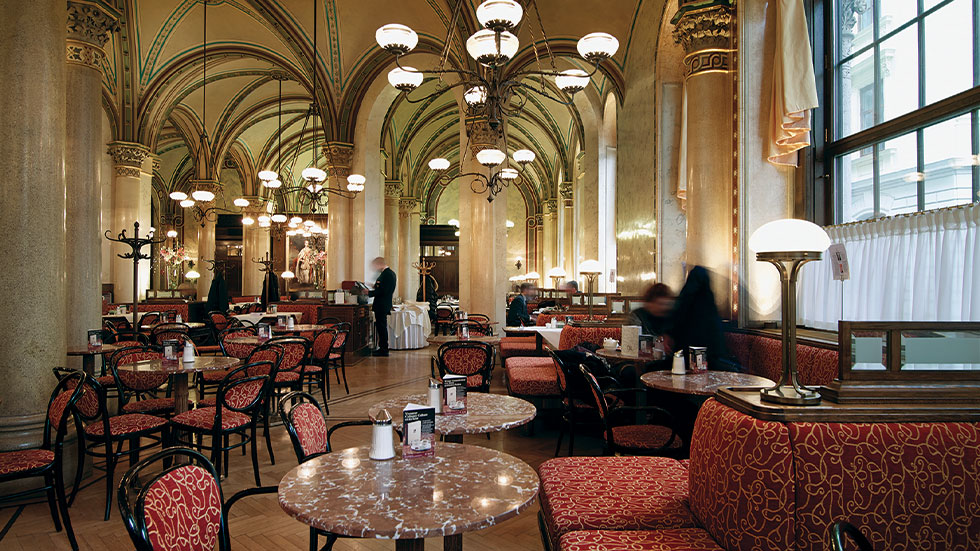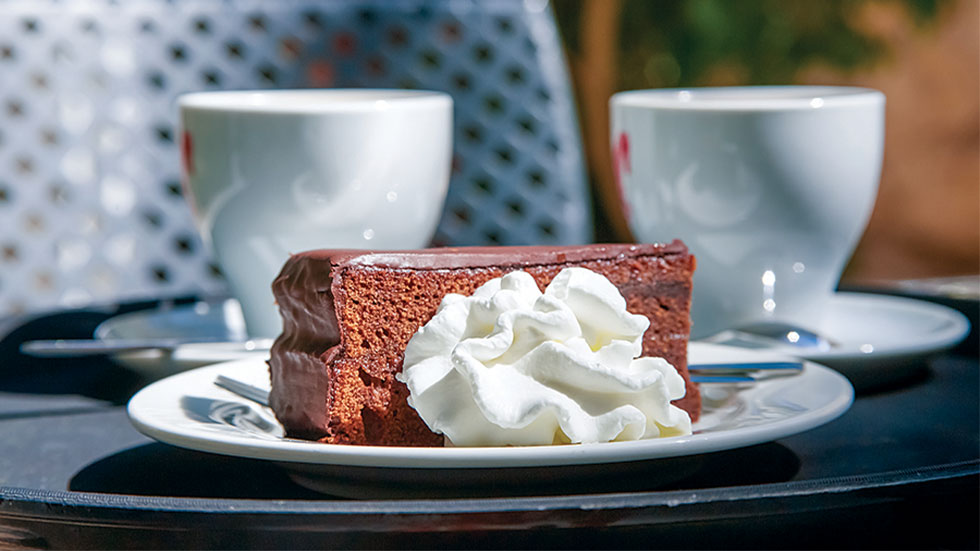Vienna: Austria’s Cosmopolitan Capital
Why 4 million annual visitors find Vienna a cultural delight

It’s a crisp Saturday morning and Naschmarkt—Vienna’s famed food market that dates to the 16th century—is bustling with life and provisions. Here, more than 100 stands brim with pastries, breads, cheeses, cured meats and fresh produce, each display more tempting than the previous one. I am hungry, so I eagerly follow my tour guide, Cristina-Estera Klein of Austria Guides For Future, to the stand that serves kaiserschmarrn—a light and fluffy shredded pancake eaten with plum and apple sauce. Sweet and juicy, the Austrian traditional breakfast proves worth the wait.
 Kaiserschmarrn is a traditional Austrian breakfast; Photo by Andrear/stock.adobe.com
Kaiserschmarrn is a traditional Austrian breakfast; Photo by Andrear/stock.adobe.com
“Kaiserschmarrn literally means emperor’s mess,” Klein tells me. “It can be eaten for breakfast but also as a dessert.”
Like many other things in Vienna, the dish comes with a legend. Kaiserschmarrn, I learn, owes its name to the fact that it was first created for Emperor Franz Joseph and his wife, Elisabeth. She was determined to maintain her famously slender figure and requested that her chef make very light desserts. Whether the first iteration was indeed a jumbled concoction or not isn’t known, but the name stuck, and the dish remains Austria’s favorite breakfast some 150 years later.
 Old and new architecture exist side by side in Vienna; Photo by Roman Babakin/stock.adobe.com
Old and new architecture exist side by side in Vienna; Photo by Roman Babakin/stock.adobe.com
Vienna is one of those cities that blends history and modernity with total ease. Once the seat of the Habsburg kingdom and the Holy Roman Empire, Vienna was among the richest cities in Europe. Largely spared the destruction of the two world wars, most of its imperial architecture is preserved to this day, so walking in this beautiful city center feels like traveling back in time.
Yet, when you step away from the opulent palaces, modern storefronts beckon with the latest fashions in clothing, handbags and jewelry. Throughout the city, coffeehouses—some dating to the mid-19th century—neighbor modern cafés, while historic landmarks elbow new, postmodern architecture. When the bell of St. Stephen’s Cathedral strikes midnight on New Year’s Eve, the Viennese dance their traditional waltz in public squares nearby—a charmingly old-fashioned tradition. In summer, they grow vegetables on urban farms, leading the 21st-century sustainable agriculture movement.
Trees and flowers abound. In 2022, Vienna placed first on the World’s 10 Greenest Cities list as determined by Resonance, a consultancy group for real estate, tourism and economic development. More than once, The Economist has named it the “world’s most livable city” for its clean air and overall quality of life, again putting the city at the cutting edge of modern sustainability.
So, it’s hardly surprising that about 4 million travelers annually visit the posh and airy Austrian capital on the shores of the Danube River, which is also a popular cruise port.
 Café Central has been a noted coffeehouse since 1876; Photo by Christian Stemper/Wientourismus
Café Central has been a noted coffeehouse since 1876; Photo by Christian Stemper/Wientourismus
COFFEEHOUSE CULTURE
When the tour of the market concludes, Klein and I walk through the city. “Let me know when you’re ready for coffee,” she says as we pass by yet another coffeehouse. “I’ll tell you the best ones.”
I already know I can’t visit them all—there’s exactly 130 of them in Vienna, each serving a long list of caffeinated delights, some with milk, some with whipped cream and others with liqueur.
Not surprisingly, the origin of Viennese coffee culture is also steeped in legend. It was the Ottomans who “spilled the beans” when they were defeated by the Polish–Habsburg army at the second Turkish siege of Vienna in 1683. As they retreated, they reputedly left sacks of coffee beans behind. At the time, most Europeans cared little for coffee, but Polish officer Jerzy Franciszek Kulczycki, who was more familiar with Turkish customs, knew how to make the energizing drink, Klein tells me. The Ottomans drank their coffee black, but Kulczycki allegedly added sugar and milk, adapting the bitter brew to European tastes. As the story goes, two years later, the first coffeehouse was opened by a man named Johannes Theodat—and another timeless Viennese tradition was born.
Soon, Viennese coffeehouses became ubiquitous, each with its own atmosphere and loyal patrons. They were social hubs where people came to learn the latest gossip, read newspapers and discuss politics. And while today many coffeehouse visitors read news on their phones, newspapers remain a hospitality symbol. Most coffeehouses still keep a stack of them—in a classically charming Viennese way that effortlessly blends yesteryear with the 21st century.
On Klein’s recommendation, I drop into Café Central, a coffeehouse once favored by Sigmund Freud and Leon Trotsky. The café’s ambience—curvy vintage chairs with embroidered silk cushions and tall marble arches—make me feel as if the two luminaries might walk in at any second. Talking to my waiter, I learn some specific coffee slang: “schlagober,” or “ober” for short, means whipped cream. My espresso “mit ober” arrives with a fluffy dollop floating on top, satisfying my sugar and caffeine cravings.
 Schõnbrunn Palace was the summer home of the Viennese court; Photo by Mistervlad/stock.adobe.com
Schõnbrunn Palace was the summer home of the Viennese court; Photo by Mistervlad/stock.adobe.com
IMPERIAL HISTORY
The Habsburg dynasty ruled Austria from 1282 until 1918, leaving behind numerous architectural treasures and art collections. Vienna offers more than 100 museums, making it impossible to visit them all, but there are a few that should be on your list. Located in the city center and built in the 13th century, Hofburg Palace, the Habsburgs’ main residence, is one. The other is Schönbrunn Palace (sometimes called the Viennese Versailles), a “summer palace” in what was once the countryside but is now within the city limits. Back in the heart of town, the Upper and Lower Belvedere hold thousands of pieces of art, as does the Albertina Museum.
Smaller but no less exciting, the Sisi Museum tells the story of Austria’s free-spirited and defiant empress who may as well have been the Princess Diana of her time. Beautiful and strong-willed, she never accepted the stringent rules of the Viennese court. In her time, she had faced much criticism, but today she’s adored as a royal rebel, her portraits appearing everywhere from oversized posters to chocolate wrappers to the tablecloths of the innumerable coffeehouses.
 Schnitzel is another of Austria’s traditional dishes; Photo by Efesenko/stock.adobe.com
Schnitzel is another of Austria’s traditional dishes; Photo by Efesenko/stock.adobe.com
CULINARY CLASSICS
Around noon, I drop by Café Tirolerhof near the Opera House, hungrily scanning the lunch menu. Viennese cuisine—the only one in the world named after a city—is famed for a few gastronomic delights. That includes the schnitzel, a thin slice of tenderized meat fried in breadcrumbs, and tafelspitz, boiled beef soup simmered for hours to make the meat melt in your mouth. Würstels, the sausages sold at kiosks hugging squares and street corners, are another staple. After much deliberation, I settle on a schnitzel, which arrives pounded to the utmost thinness and fried in golden batter to a perfect crisp.
I save some space for a midafternoon würstel snack, visiting Michael Lanner’s würstelstand, known for his innovative take on traditional sausage flavors. Würstels first became popular in the early 1800s, after the Napoleonic Wars bankrupted Austria and meat prices surged, pushing the poor to utilize every scrap. Returning from the war, disabled soldiers who couldn’t find work sold würstels—and a new food tradition was born. Today, this popular street food comes in many versions, including frankfurters, bratwursts and käsekrainers; the latter are infused with cheese that melts on the grill and then bursts like a scrumptious fat bomb in your mouth.
Lanner, who grew up eating würstels, decided to give the tradition a modern twist. Sourcing sausages from several artisanal butchers, he spices them up with new flavors like jalapeño, salsa criolla and curry masala. I opt for the Bosna, which is served inside a generous bun flavored with mustard and curry.
Later that evening, I arrive at Gmoakeller, a tavern known for its tasty tafelspitz. The dish comes with instructions on how to eat it in proper order. First, I ladle the fragrant shimmering broth from a huge copper pot into my bowl. After consuming the broth, I can enjoy the utterly tender beef slice, dipping it into applesauce and horseradish. As the legend goes, tafelspitz was Franz Joseph’s favorite. He preferred it to the elaborate multicourse dinners that were more common in that era—and he ate it almost every day.
 Vienna’s famed Sacher-Torte; Photo by Kira/stock.adobe.com
Vienna’s famed Sacher-Torte; Photo by Kira/stock.adobe.com
On my way to the hotel, I give in to temptation at L’Opera, a café that serves traditional desserts in a colorful setting. My Sacher-Torte, a rich chocolate cake layered with apricot jam, arrives snuggled with a snow-white serving of whipped cream—and encased in yet another legend. In 1832, Prince Metternich of Austria requested a superior dessert for a special occasion. The palace chef had fallen ill that day, so 16-year-old apprentice Franz Sacher had to fill in. Sacher whipped up a cake recipe that remains an iconic classic loved by millions.
Before I dig in, I pause to admire the dish’s black-and-white beauty—and marvel at the uniquely Viennese ways to fuse the last several centuries into a singularly delightful experience. It’s one of the few places on the planet where you can be in several eras at once—and love every minute of it.
